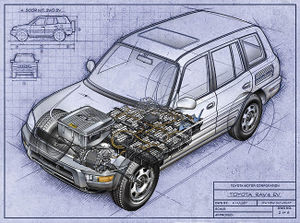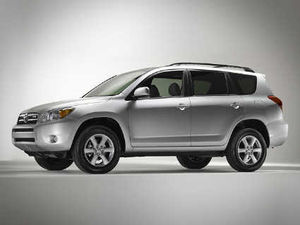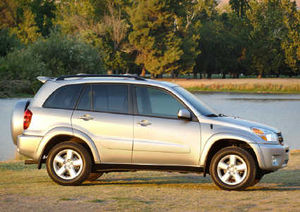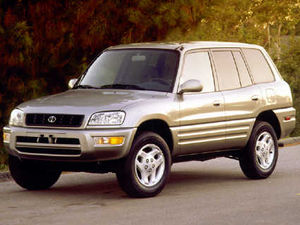.
Toyota RAV4: Difference between revisions
| Line 11: | Line 11: | ||
===Pricing=== | ===Pricing=== | ||
[[Image:corollaengine.jpg|frame|Engine of 2006 '''[[Toyota]] Corolla''']] | |||
<table border=1 tablecolor=#000000 bordercolor=#000008> | |||
<tr bgcolor=#cccccc> | |||
<td colspan=12> | |||
'''RAV4 Trim''' | |||
</td> | |||
</tr> | |||
<tr bgcolor=#ffffcc> | |||
<td> | |||
'''Base FWD''' | |||
</td> | |||
<td> | |||
'''Base [[V6]] FWD''' | |||
</td> | |||
<td> | |||
'''Base 4x4''' | |||
</td> | |||
<td> | |||
'''Base [[V6]] 4x4''' | |||
</td> | |||
<td> | |||
'''Sport FWD''' | |||
</td> | |||
<td> | |||
'''Sport [[V6]] FWD''' | |||
</td> | |||
<td> | |||
'''Sport 4x4''' | |||
</td> | |||
<td> | |||
'''Sport [[V6]] 4x4''' | |||
</td> | |||
<td> | |||
'''Limited FWD''' | |||
</td> | |||
<td> | |||
'''Limited [[V6]] FWD''' | |||
</td> | |||
<td> | |||
'''Limited 4x4''' | |||
</td> | |||
<td> | |||
'''Limited [[V6]] 4x4''' | |||
</td> | |||
</tr> | |||
<tr> | |||
<td colspan=4 bgcolor=#ccccc> | |||
'''Price''' | |||
</td> | |||
</tr> | |||
<tr bgcolor=#66ccff> | |||
<td colspan=4> | |||
''MSRP'' | |||
</td> | |||
</tr> | |||
<tr bgcolor=#ffffcc> | |||
<td> | |||
$20,300 | |||
</td> | |||
<td> | |||
$22,335 | |||
</td> | |||
<td> | |||
$21,700 | |||
</td> | |||
<td> | |||
$23,735 | |||
</td> | |||
<td> | |||
$21,875 | |||
</td> | |||
<td> | |||
$23,790 | |||
</td> | |||
<td> | |||
$23,275 | |||
</td> | |||
<td> | |||
$25,190 | |||
</td> | |||
<td> | |||
$22,555 | |||
</td> | |||
<td> | |||
$24,470 | |||
</td> | |||
<td> | |||
$23,955 | |||
</td> | |||
<td> | |||
$25,870 | |||
</td> | |||
</tr> | |||
<tr bgcolor=#66ccff> | |||
<td colspan=9> | |||
''Invoice'' | |||
</td> | |||
</tr> | |||
<tr bgcolor=#ffffcc> | |||
<td> | |||
$18,778 | |||
</td> | |||
<td> | |||
$20,658 | |||
</td> | |||
<td> | |||
$19,747 | |||
</td> | |||
<td> | |||
$21,597 | |||
</td> | |||
<td> | |||
$20,232 | |||
</td> | |||
<td> | |||
$22,003 | |||
</td> | |||
<td> | |||
$21,178 | |||
</td> | |||
<td> | |||
$22,920 | |||
</td> | |||
<td> | |||
$20,862 | |||
</td> | |||
<td> | |||
$22,633 | |||
</td> | |||
<td> | |||
$21,798 | |||
</td> | |||
<td> | |||
$23,540 | |||
</td> | |||
</tr> | |||
</table> | |||
Today's actual prices by city can be found at [http://www.carsdirect.com/toyota/rav4/prices CarsDirect]. | |||
===Gas Mileage=== | ===Gas Mileage=== | ||
Revision as of 18:28, 28 June 2006
The Toyota RAV4 (pronounced "rav-four") is a compact crossover SUV built and marketed by the Toyota Motor Corporation. It was introduced in Japan in 1994 and in the US in 1996 to cater to consumers wanting a vehicle that had most of the benefits of SUVs, such as increased cargo room, higher visibility, and the option of four wheel drive, along with the maneuverability and fuel economy of a smaller car. The early success of the RAV4 paved the way for other compact SUVs such as the Honda CR-V, the Ford Escape/Mazda Tribute, and the Subaru Forester. Its name stands for "Recreational Activity Vehicle, 4-wheel drive," although not all models have four wheel drive as this is optional in some countries.
See WikiCars' comprehensive Toyota RAV4 Review.
Recent Changes
Styles and Major Options
Pricing
|
RAV4 Trim |
|||||||||||
|
Base FWD |
Base V6 FWD |
Base 4x4 |
Base V6 4x4 |
Sport FWD |
Sport V6 FWD |
Sport 4x4 |
Sport V6 4x4 |
Limited FWD |
Limited V6 FWD |
Limited 4x4 |
Limited V6 4x4 |
|
Price |
|||||||||||
|
MSRP |
|||||||||||
|
$20,300 |
$22,335 |
$21,700 |
$23,735 |
$21,875 |
$23,790 |
$23,275 |
$25,190 |
$22,555 |
$24,470 |
$23,955 |
$25,870 |
|
Invoice |
|||||||||||
|
$18,778 |
$20,658 |
$19,747 |
$21,597 |
$20,232 |
$22,003 |
$21,178 |
$22,920 |
$20,862 |
$22,633 |
$21,798 |
$23,540 |
Today's actual prices by city can be found at CarsDirect.
Gas Mileage
|
RAV4 MPG |
||||||||
|
2WD |
4WD |
|||||||
|
4-Cylinder |
||||||||
|
24/30 |
23/28 |
|||||||
|
22/29 |
21/28 |
|||||||
Reliability
Safety
Photos
Colors
Main Competitors
Hybrid/Electric Models
The RAV4 was available in an all-electric version called the RAV4 EV from 1997-2002. Its drivetrain is powered exclusively by 24 12-volt batteries which can be recharged from being fully-depleted to fully-charged in about 5 hours.
The RAV4EV governs top speed of 80 miles per hour, and a range of 80-120 miles on a full charge. Mileage depended on the same factors as a traditional gasoline-powered vehicle, mainly tire drag and average speed (aerodynamic drag). The RAV4EV has 24 12-volt 95Ah NiMH batteries capable of outputting 27.4kWh of energy. As of May, 2006, charging a RAV4EV from full-dead to full-charge, at a rate of US$0.09 per kilowatt-hour, costs around $2.70. As of May, 2006, this compares to a price-per-gallon cost of US$3.00, and makes mileage in the RAV4EV the cost equivalent to a 111.1-mile-per-gallon small SUV.
The RAV4EV has been demonstrated to outperform the traditional RAV4 in acceleration tests, and is capable of operating with the flow of traffic at any posted speed limit in the United States.
The RAV4EV's battery system is a wearable item, and current costs are approximately US$26,000 to replace the battery pack, due to short supply. While some owners have chosen to replace the batteries at around 50,000 miles, there are owners that currently have over 100,000 miles without issue. The development of powerful Lithium Ion batteries will make a large difference in this cost, as well as extend the range of the RAV4EV considerably. The remaining systems in the RAV4EV are comparable to the gas-powered RAV4, such as power brakes, power steering and air conditioning. These systems are of equal cost to maintain as the gas-powered RAV4.
RAV4 EV pre-production prototypes were first released in a confidential evaluation program with electric utilities throughout the U.S. These prototypes were based on the smaller, shorter, 2-door version of the RAV4. Prototypes were well accepted.
RAV4 EVs were only available for sale at a few dealerships beginning in 1997, and were mostly on 5-year lease to companies in southern California.
Beginning in February, 2002, the public could buy or lease this zero-emissions SUV in limited quantities at participating Toyota dealers in the Los Angeles and San Francisco regions. The MSRP was $42,000; but in California, rebates of $9,000 and a $3,000 credit from the Internal Revenue Service brought the price down to a more palatable $30,000, including the home charger. The RAV4 EV was meant to give Toyota additional vehicles to address the California Air Resources Board's zero-emissions vehicle (ZEV) mandate, which required 2% of a manufacturer's vehicle sales within the state to be ZEV's. The RAV4 EV was sold to the public for eight months, until the spring of 2003. The vehicle's retail had outsold its demand far faster than they could be supplied to market, despite very little advertising, and few people had ever been aware that they were available.
Toyota discontinued the RAV4 EV program one day after the passing of new air-quality requirements by CARB. CARB eliminated most of the ZEV requirement, substituting a greater number of partial zero-emissions vehicles (PZEVs) to meet the requirement. A Super Ultra Low Emissions Vehicle (SULEV) category was also added. This program requirement was designed to obtain equivalent emissions reductions by substituting less expensive, more general purpose vehicles.
Unlike other manufacturers, Toyota did not recall vehicles, destroy them, and completely terminate the program. While no longer sold, the vehicle is still supported by selective Toyota service centers (mainly in southern California) and a strong owner community. The RAV4EV is driven daily by hundreds of owners, now across the country. These owners have built up an online community and have worked out ways to add options to the RAV4EV never offered by Toyota, with the most popular being keyless door entry and cruise control.
Toyota has not expressed interest in reviving the RAV4 EV line. Proponents for the RAV4 EV are hopeful that manufacturing processes will someday yield low-cost batteries capable of being powerful enough for the RAV4 EV drive system, and at a price that would be considered reasonable by the general public.
Unique Attributes
Resale Values
Criticisms
Current Generation: (2006–present)
The Toyota RAV4 was completely redesigned for the 2006 model year. It still has a 2.4 L four-cylinder engine, which now produces 166 hp, up 5 from last year. Unique to North America, the new RAV4 also includes a new 3.5 L V6 engine from the Toyota Avalon, making 269 hp. The RAV4 is up by 21 percent in interior volume from the last generation and now has an available third row seat for two small children. The RAV4 can still be had in either front wheel drive or four wheel drive in North America, however most countries only sell the four wheel drive version.
For now, the RAV4 models sold in North America are produced in Toyota's Tahara, Aichi, Japan assembly plant. However, when Toyota's Woodstock, Ontario, Canada assembly plant comes online in 2008, models sold in North America will be assembled exclusively there.
Previous Generations
Second generation (2001–2005)
The second generation RAV4 was offered in a single trim level and still came with front or all wheel drive. Although the RAV4 was available as a two-door in Europe, the American model was now only available in a four-door configuration. A 2.0 L I4 engine producing 148 hp was the only engine available. All RAV4s came with 16 inch wheels, anti-lock brakes, stability control, air-conditioning, a height-adjustable driver's seat, cruise control, a six-speaker CD stereo and power windows, mirrors, and heated seats.
A sport package added a mesh grille, hood scoop, color-keyed door handles, a roof rack, silver sport pedals, heated mirrors, gray-painted bumpers and overfenders and sport fabric seats. Other options included alloy wheels, a sunroof and keyless entry. Larger tires were also available on all wheel drive models.
In 2004, the RAV4 was slightly restyled, and a 2.4 L I4 engine producing 161 hp replaced the 2.0 L engine as standard equipment. The second generation RAV4 has proved extremely popular in Australia, where it became the best-selling SUV in the country in 2001. In 2004, it was the best-selling compact SUV.
First Generation/Origins (1994-2000)
The RAV4 was offered in both two and four-door versions. In the US, a 2.0 L I4 engine producing 120 hp was offered. Both front wheel drive and all wheel drive were available, and the RAV4 could be had with either a five-speed manual or four-speed automatic transmission. In 1998, the RAV4 was slightly restyled on the front and rear fascias, and a soft-top two-door was made available. In 1999, the two-door hardtop was dropped from the American lineup.




